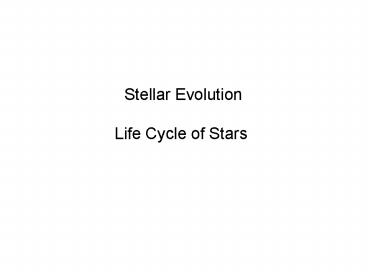Stellar Evolution Life Cycle of Stars PowerPoint PPT Presentation
1 / 26
Title: Stellar Evolution Life Cycle of Stars
1
Stellar EvolutionLife Cycle of Stars
2
Star Properties
- Representative versus Prominent Stars
- HR diagram and main sequence
- Russell-Vogt Theorem
- Non-Main Sequence Stars
- High luminosity K and M stars Red Giants
- Super Giants
- Low luminosity A, F, and G stars White Dwarfs
3
(No Transcript)
4
Luminosity Classes
- Higher luminosity stars less dense thinner
spectral lines - Luminosity Classes
- I gt Super Giants
- II gt Bright Giants
- III gt Giants
- IV gt Sub Giants
- V gt Main Sequence
5
Relationships
- Mass Luminosity
- Main Sequence more mass higher luminosity
- L 8 M3.5
- Luminosity Radius
- Main Sequence larger size greater luminosity
- Luminosity Temperature
- Main Sequence higher temperature greater
luminosity - Hydrogen Burning Lifetime
- ? M/L x (9 billion years)
6
Stellar Evolution
- Evidence that Stars Continue to Form
- Large MS stars short lifetime
- 20 M?s 100 million years
- Star clusters with large MS stars must be young
- Sun is 5 billion years old universe 10 13
billion - Open Clusters drift apart with time yet we see
these clusters, i.e. they formed recently
7
Protostar (1)
- Stellar nebula
- Cloud of gas (and dust) from which star forms
- Compositon
- Mostly hydrogen, some helium
- Other components (figure 18-1)
- CO2, H2O, H2CO, C2H5OH, etc.
- Temperature 10 to 20 K
- Density 1 molecule per cm3
8
Density Comparisons
- Iron (solid) per cm3
- Water (liquid) per cm3
- Air (gas) 2 x 1019 per cm3
- Interplanetary Space per cm3
- Molecular Nebula 1 per cm3
9
Gravitation Collapse
- Molecular Cloud
- Turbulence likely to start gravitation collapse
- Density increases pocket of greater density
mass - Gravitational attraction draws mass together
- Energy of Molecules Increases
- Conversion of gravitational energy to kinetic
energy - Gravitational force accelerates molecules
- Increase in velocity increases in temperature
- Increase in density
10
(No Transcript)
11
Change of Cloud Properties
- Change is size
- Molecular cloud ? 100 AU
- Radius of Star 0.2 10 Rs (0.001 0.05 AU)
- Change in Temperature
- Molecular Cloud 10 20 K
- Star 2500 40,000 K surface
- 15 to 100 x 106 K core
- Temperature increase ? 1/r
- Density ( mass/volume)
- Density ? 1/r3
12
Competition of Gravity and Pressure
- Gravitational force
- Mass and size
- Conversion of Gravitational to Kinetic Energy
- Pressure
- Temperature and density
- Jeans Size or Mass
- MJ 1036 kg ( 109 Ms)
13
Mass Limits for Star Formation
- Most Stars from 0.2 to 20 Ms
- Lower mass limit is 0.08 Ms (Jupiter is 0.016)
- Upper limit is 150 Ms
- Eta Carina estimated 100 150 Ms
14
Protostar Formation
- Rotation and disk formation
- Development of high temperature in core
- Core Temperature reaches 106 K
- Deuterium burning
- T-Tauri Stars
- Protostar Phase for between 106 to 108 years
depending on mass (high to low)
15
Protostar Formation (2)
- Core Temperature reaches 106 K
- Deuterium burning
- Bipolar jets of gas
- Disk accretion of material
- T-Tauri stars
- Herbig Haro Objects
- Protostar Phase for between 106 to 108 years
depending on mass (high to low)
16
Protostar (3)
- High speed episodic stellar winds remove excess
gas - Bok Gloubues
- Herbig-Haro Objects
- High mass stars and their winds may inhibit
formation of small mass stars
17
(No Transcript)
18
(No Transcript)
19
(No Transcript)
20
T-Tauri Stars
- Protostars evolving to Main Sequence Status
- Low mass 02. to 2 Ms, spectral types F to M
- Extensive convection zone and strong magnetic
activity - Found close to or within dusty clouds
- Fluctuations in brightness
- Bipolar jets
- Accretion from Disk
21
(No Transcript)
22
(No Transcript)
23
(No Transcript)
24
(No Transcript)
25
(No Transcript)
26
Thermonuclear Energy Production in Stars

